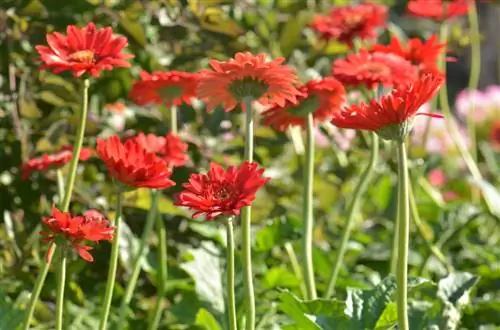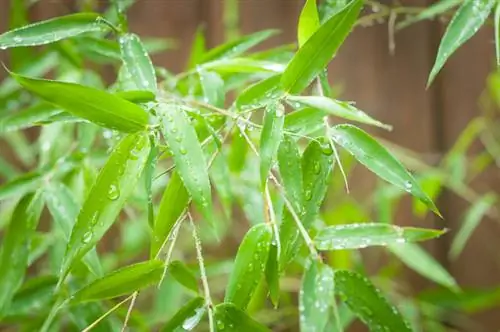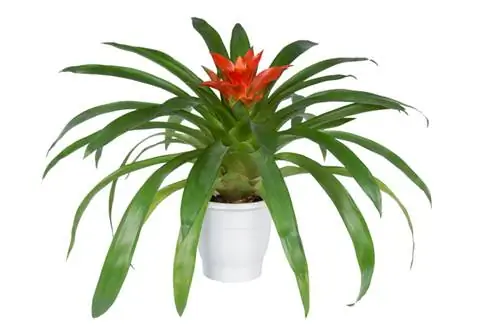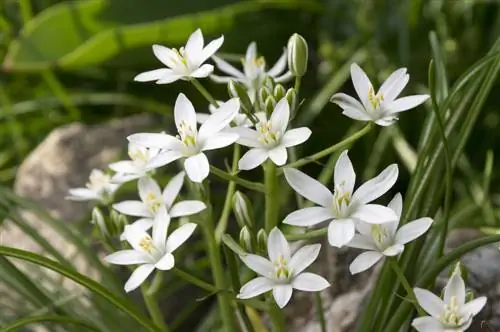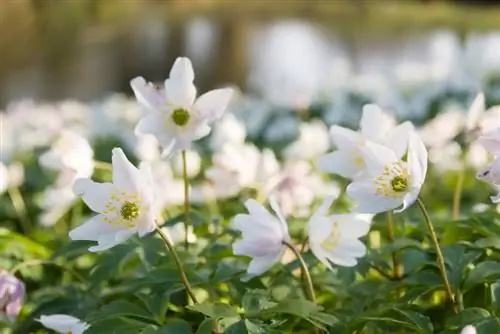- Author admin [email protected].
- Public 2024-01-02 03:03.
- Last modified 2025-01-23 11:22.
She is considered the incarnation of a cheerful, colorful flower. Gerbera gives bouquets more pep, windowsills cheerful elegance and gardens summery lightness. Don't let open questions stop you from cultivating, because you can read all the important answers here.
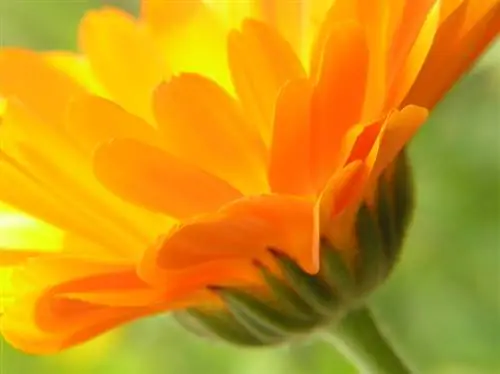
How do you properly care for a gerbera?
To care for gerberas properly, you should water them regularly from below, spray them with lime-free water every few days, administer diluted liquid fertilizer weekly from April to August, clean them out regularly, repot houseplants in spring and overwinter them in a bright and cool place.
Planting gerberas correctly
So that gerbera blooms in the bed all summer long, plant the flower professionally in these steps:
- The planting pit is twice as big as the root ball
- Optimize the excavation with compost (€10.00 on Amazon) and horn shavings
- Set the potted flower exactly as deep as before
- Press down the soil, water it and mulch it organically
A planting distance of 45-50 centimeters is considered appropriate. In moist soil, drainage made of gravel or clay shards at the bottom prevents harmful waterlogging.read more
Care tips
The care protocol for a gerbera includes these TOPs:
- Water the flower from below when the substrate is slightly dry
- Spray with lime-free water every few days
- Administer diluted liquid fertilizer once a week from April to August
- Clean regularly
- Repotting houseplants in spring
- Winter bright and cool
The watering of gerberas is not stopped at any time of the year, but is tailored to the conditions at the location.
Which location is suitable?
The top priority when choosing a location for a gerbera is a light-flooded, airy place without direct midday sun. During the summer, temperatures of 20-25 degrees Celsius cause the flower to produce its most beautiful blooms. In winter, a cool, bright place is required where the mercury fluctuates between 12 and 15 degrees.read more
When is flowering time?
Gerbera blooms from May to September when planted in a bed. If the flower thrives on the protected windowsill, it radiates its floral charm from April to October.read more
cutting gerberas correctly
Cutting a gerbera is mandatory for several reasons:
- To preserve the flowering, cut off withered flower stems and leaves
- To use the flower as a vase decoration
- Before moving to winter quarters
read more
Watering gerberas
The flower should never dry out. When the summer is dry, water more often than during the winter. Always administer the water from below by briefly placing the pot in water.read more
Wintering
To overwinter a gerbera properly, carry the flower in the pot into a bright room with temperatures of 12-15 degrees Celsius. If the plant spent the summer in the bed, cut off all withered stems and leaves in the fall. Then dig up the flower, place the root ball in a pot with fresh, well-drained substrate and place it in the winter quarters with the indoor gerberas.read more
Propagate Gerberas
If a gerbera gets old, its willingness to bloom leaves something to be desired. Now the time is ripe for skillful propagation. You have the choice between these three methods:
- Sowing the seeds
- Division of roots
- Cuttings
read more
Is gerbera poisonous?
The gerbera does not contain any toxic ingredients. Since the colorful flower has a strong attraction for small children and curious pets, it should be placed out of reach of two- and four-legged researchers.read more
Pulling the gerberas outside
Growing a gerbera is by no means limited to the room. From mid-May the flower enjoys the sun and fresh air on the balcony. In addition, the tropical beauty thrives wonderfully in sunny, fresh, moist beds. When it comes to outdoor care, it's all about ensuring a sufficient supply of water, because the flower must not dry out under any circumstances. If a dose of fertilizer is added every week and any wilted parts are cleaned out, the gerbera will use all its flower power.read more
The gerbera in the garden
Gerberas thrive more vitally and lushly in the garden than on the windowsill at home. So plant the enchanting flower from May onwards in a bright spot without blazing midday sun in nutrient-rich, fresh, moist soil. For the best starting conditions, enrich the substrate with compost (€10.00 on Amazon) and horn shavings. It is important to note that the flower should not be planted any deeper than in the growing pot and that a planting distance of 50 centimeters should be taken into account. Regular watering and weekly fertilization round off the care program.read more
Is the gerbera hardy?
It is considered a botanical sensation and opens up new facets in gerbera culture. Knowledgeable breeders have succeeded in creating the first hardy flower within the genus. The white-flowering Garvinea can withstand temperatures down to -5 degrees Celsius. As a result, it cannot completely do without winter protection in harsh locations. All other Gerbera species and varieties have no frost resistance whatsoever.read more
Is the gerbera perennial?
The charming gerbera has the potential for multi-year cultivation. In order for the plan to succeed, these precautions are important:
- Dig up the flower in the bed before the first frost
- Place in a pot with loose substrate
- Overwinter in a bright location at 12-15 degrees Celsius
- Water little and do not fertilize
Houseplants move to similar quarters in autumn to spend the winter growth break.read more
The Gerbera as a houseplant
As a houseplant, the gerbera requires attention to these care aspects:
- Water regularly from below
- Fertilize weekly from April to August
- Immediately cut off faded stems and wilted leaves
- Repot in spring
read more
What to do if the gerbera flowers in the pot?
If the gerbera blooms prematurely in the pot, it is usually due to negligence in care. Take a close look at the location and check the water and nutrient balance. If in doubt, repot the flower in fresh substrate and place it on the sunny, airy balcony for a while.read more
The gerbera on the balcony
Once the ice saints have passed by, the sunny balcony is the ultimate feel-good climate for gerberas. Protected from the blazing sun, watered regularly and fertilized weekly, the flower in this location shows its tropical beauty to perfection.read more
The flower of the gerbera
When children draw a flower, it usually resembles a gerbera. This is hardly surprising, given their characteristic flower shape:
- A flower basket made of tubular flowers is surrounded by 2 to 3 wreaths of tongue-shaped bracts
- Double flowers contain significantly more tubular and bracts
- The flower diameter ranges from 5 to 15 centimeters
You can choose between single-color and two-color varieties. All conceivable colors are represented. The only thing the flower hasn't dressed in blue so far is.read more
The gerbera blooms in these colors
The gerbera brightens up the day with a firework of bright colors. An almost unmistakable spectrum of nuances leaves nothing to be desired. Starting from the basic colors white, red and yellow, the genre unfolds a festival of colors that goes beyond the scope of even professional color theory. Two-colored cultivars are no longer uncommon. Multicolor gerberas have long been on the rise.read more
The gerbera in the vase
These precautions will help you enjoy gerberas in your vase for a long time:
- Cut the flower when the inner flower tubes are still closed
- clean the vase meticulously
- Fill in fresh water up to a maximum of 5 centimeters
- Cut the stem base repeatedly at an angle
read more
How to care for the gerbera as a cut flower
Gerbera is particularly capricious as a cut flower. In this regard, exemplary care includes the following criteria:
- Oblique cutting of the stem base every 2-3 days
- Regular replacement of water
- Water level at a maximum of 5 centimeters
In addition, the addition of special fresh flowers is recommended.read more
Drying gerbera flowers
Drying gerberas is very easy. Cut the flower when it has fully bloomed. Then hang the stems upside down individually or tied into small bouquets. In an airy, rain-protected location, the process takes 2-3 weeks.read more
Cut off spent flowers
Cut off spent flowers from a gerbera immediately and kill two birds with one stone. The flower is motivated to bloom again and the neat appearance is immediately restored.read more
Gerbera seeds
In order to get the seeds of a gerbera into a germination mood, a constant temperature of 23-25 degrees Celsius is required in a partially shaded location. If you put a transparent hood over the seed container, the warm, humid microclimate will further promote the process.read more
Winning Gerbera Seeds
In order to obtain the seeds from a gerbera, the flower must be completely dried. Then collect the seed heads with a hair wreath, dry them in a bowl and keep the seeds dry and dark until next spring.read more
Is gerbera poisonous to cats?
Gerbera poses no danger to cats. On the contrary, the flower is recommended if you want your window sill, balcony and garden to bloom in a cat-safe way.read more
The most beautiful varieties of Gerbera
From the manageable number of 30 Gerbera species, generations of gifted breeders have created an almost unmissable we alth of brilliant varieties. The range of products on offer extends from the mini gerbera with 5-8 cm small flowers to the standard flower with 12.5 cm flower wreaths up to the giants with 15 cm flower diameters.read more
- Aladin: 9-12 cm large, simple flowers in dark purple with a black eye
- Befi: lush double pompom flowers in delicate pink, with a black eye
- Germini Freddy: bright yellow flower sun, full to the brim and with a bright eye
- Ambiance: sensational bi-color gerbera with pink petals, pink wing tips and a dark heart
- Alain Ducasse: two-tone beauty in cream and pink with a black heart and densely filled
- Avignon: a noble gerbera with double flowers in elegant apricot
- Dark Diamond: large-flowered variety with impressive flower wreaths in rich burgundy
- Kimpsey: Mini gerbera with 8 cm small, densely double flowers in delicate pink


